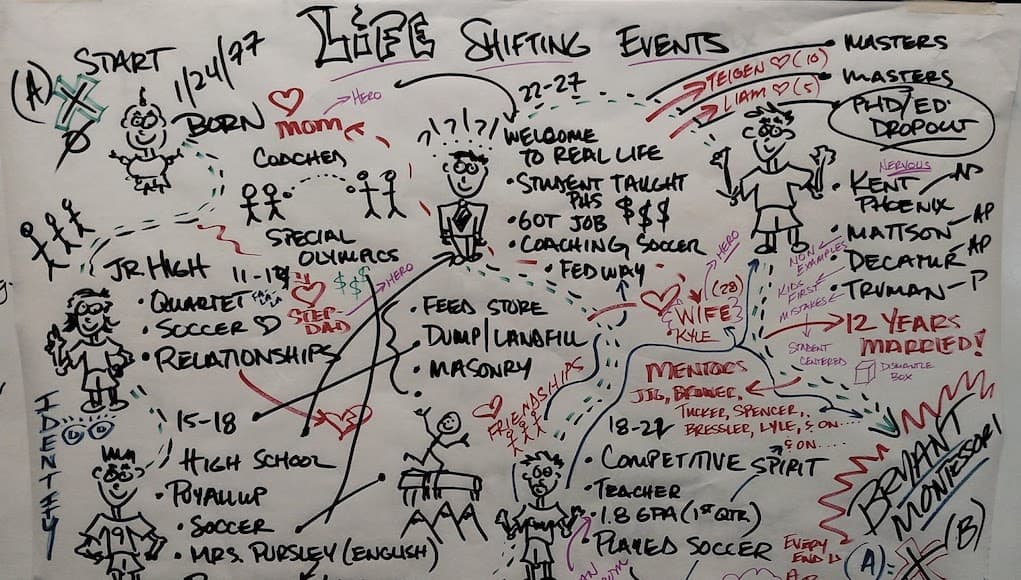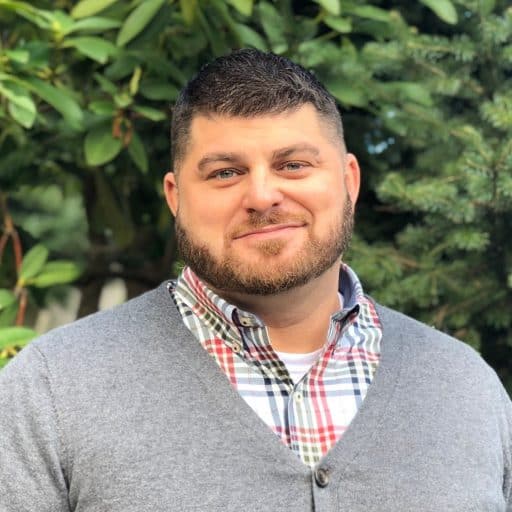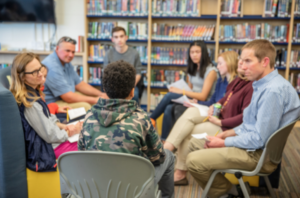Mapping Learner Experience

As students navigate their learning journey, we must deliver explicit, student-owned opportunities to set and map their course. While there are non-negotiables around the outcomes of graduation and promotion, we need to continuously pursue and design opportunities that are grounded in student navigation. I fondly remember framing what I originally entitled “life mapping” as a presentation add-on to introduce myself to my very first AVID elective class in 2006. It was an illustration that I had hoped would support the delivery of my experience as a learner with an end goal that highlighted my personal and professional “nexts.” The creation of the concept was delivered during one of those late teacher nights that lead up the opening of the school year and while I did not know then, would become my relationship platform starter for many years to come.
 I was fresh off my first attendance of an AVID annual conference (which I would recommend to any educator who desires to improve their abilities as a champion for kids) and was hyper-focused on designing opportunities to increase my ability to develop relationships with my students. I reflected on my own learning journey and “mapped” it out. With the skills of a self proclaimed semi-pro doodler, I quickly found correlation to family road trips that we would take as kids. Regardless of where we traveled (always by car), there were detours and stops made along the way. I remember snow delays on the interstate and vehicle issues that created problem solving opportunities and found clear connections to my own journey as a learner. This visual evolved into connection to the original National Lampoon’s Vacation movie with a clip that illustrates setting up for their trip to Wally World, which I eventually used in class as comic relief around the evolution of technology and all of the entertaining elements that go into planning a trip.
I was fresh off my first attendance of an AVID annual conference (which I would recommend to any educator who desires to improve their abilities as a champion for kids) and was hyper-focused on designing opportunities to increase my ability to develop relationships with my students. I reflected on my own learning journey and “mapped” it out. With the skills of a self proclaimed semi-pro doodler, I quickly found correlation to family road trips that we would take as kids. Regardless of where we traveled (always by car), there were detours and stops made along the way. I remember snow delays on the interstate and vehicle issues that created problem solving opportunities and found clear connections to my own journey as a learner. This visual evolved into connection to the original National Lampoon’s Vacation movie with a clip that illustrates setting up for their trip to Wally World, which I eventually used in class as comic relief around the evolution of technology and all of the entertaining elements that go into planning a trip.
At first presentation, students delivered mixed emotions. Some expressed anxiety about their abilities to create, while others were excited to highlight their artistic abilities in sharing their journey. As we dove into the project, students who were once confident and ready to create found moments of hesitation as they teased out different events that had occurred over their first 15 or so years of learning. In wanting to set them up for success, I shared my milestones like graduation, but also offered some peace in sharing the 1.8 GPA in my first quarter of college, the divorce of my parents at age 4 and everything in between. I knew that I needed to help them discover their story beyond letter grades and awards and knew that it could only be done by celebrating all aspects of the journey. The products of this visioning activity provided an anchor to use as a reset when times got tough and allowed us to progress monitor the experience. At the conclusion of the year (or time determined by student goals), we would add destination “C” and continue the trip.

The target was simple: I wanted my high school students to recognize and capture where they had been, with intentionality around illustrating where they wanted to go.
The experience, initially and in replication throughout the years, sparked remembrance of milestones that had slipped from front-of-mind and also new hope in preparing to tackle some of the obstacles that would lie ahead. Common ground was met and in all of the years and formats, the completion rate has never been less than 100%. More importantly, the foundation for relationships within our newfound AVID family and the “families” since were accelerated by sharing our personalized stories.
This project evolved over the years and was aided by new learning, reflections and participant feedback. While many have contributed to the improvement of the design, I would mention and strongly endorse reading Stories That Move Mountains (Sykes/Malik/West), Unfolding the Napkin (Roam) and, most recently, Designing Your Life (Burnett/Evans). These books, each contributed deeper learning that was naturally aligned to the concept. I found ways to integrate the experience into leadership classes, professional development and used it as a base to transform advisory. The clarity and flow of setting up the project expanded with new learnings and access to a wider range of creation tools, but stayed firmly grounded in the initial goal of providing voice and value to amplify each learner’s story.
 While I have found success in using this vehicle as an ownership accelerator for learner experience, I am not advocating that every classroom begin “life mapping’ with students (well, maybe a little). I share this example as a conversation starter, and hope that urgency is created in continuing the pursuit of whole child celebration around student ownership of their learning experience. As we design, adapt, improve and innovate education, I would challenge you to audit the buffet of systems that are required for learning and to prioritize their impact through student eyes. We must ensure that our WHY is a living, breathing evolution and insist that it contains balance in the celebration of student learning through “failure” and success. We must challenge current practices and collaboratively design desired outcomes for students, with students, as they travel through the learning experience that we have created.
While I have found success in using this vehicle as an ownership accelerator for learner experience, I am not advocating that every classroom begin “life mapping’ with students (well, maybe a little). I share this example as a conversation starter, and hope that urgency is created in continuing the pursuit of whole child celebration around student ownership of their learning experience. As we design, adapt, improve and innovate education, I would challenge you to audit the buffet of systems that are required for learning and to prioritize their impact through student eyes. We must ensure that our WHY is a living, breathing evolution and insist that it contains balance in the celebration of student learning through “failure” and success. We must challenge current practices and collaboratively design desired outcomes for students, with students, as they travel through the learning experience that we have created.
We thrive on intentional design that is personalized to your school or organization’s journey in doing what is best for students. If you think you might benefit from having a partner in developing the roadmap that you have for students in regards to learner experience and beyond, contact me at [email protected]
For more, see:
- Getting Smart Podcast | Improving Learner Experience: Agency, Community, Challenge
- 15 Dimensions of Personalized Learning
- UDL: A Guiding Framework for a Personalized Learning Equity and Inclusion…
- The Role of Advisory in Personalizing the Secondary Experience
Stay in-the-know with all things EdTech and innovations in learning by signing up to receive the weekly Smart Update.




0 Comments
Leave a Comment
Your email address will not be published. All fields are required.